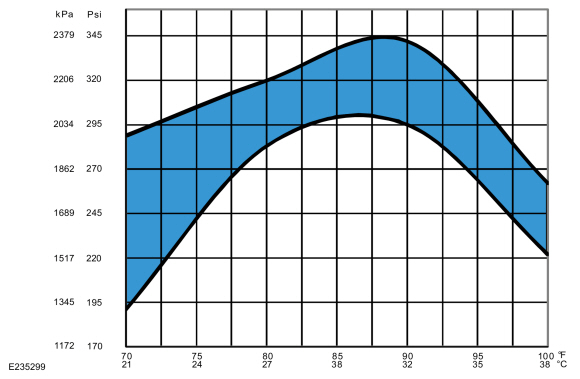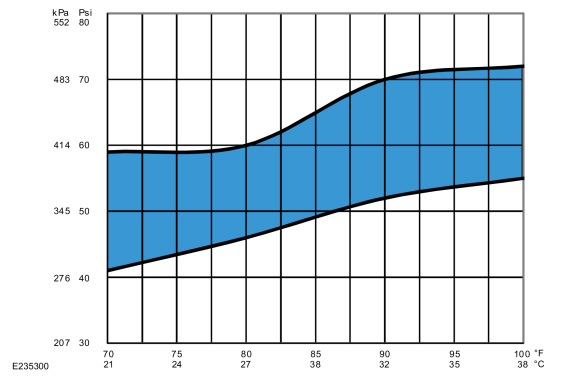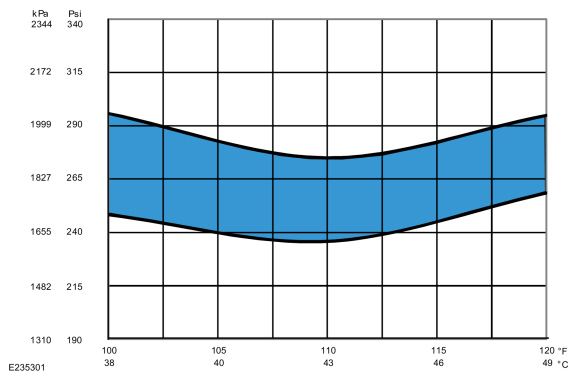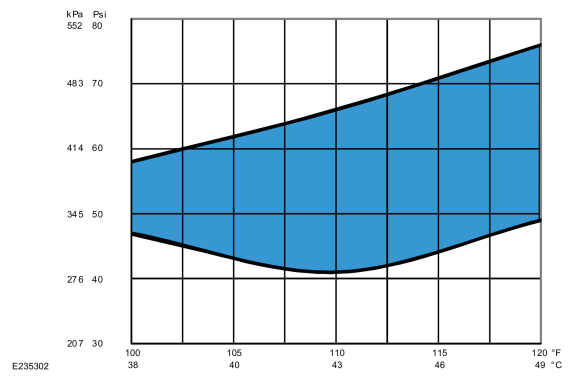Ford Fusion: Climate Control System - General Information / Refrigerant System Tests - 1.5L EcoBoost (118kW/160PS) – I4. General Procedures
Inspection
-
NOTE: Procedure 1 — Ambient Temperature below 21 °C (70 °F).
NOTE: Proper A/C system diagnosis on a vehicle’s compressor is dependent on correct refrigerant system charge and tested in ambient temperatures above 21°C (70°F). Perform the following steps to achieve normal operating pressures.
Drive the vehicle or run the engine until it reaches normal operating temperature.
-
Set the A/C system
temperature to the highest possible temperature setting with the dual
function disabled (if equipped). Manually set the blower on HI. If the
vehicle has a fresh air/recirc button, set it to recirculation. If the
vehicle has an A/C switch or compressor on switch, set it to A/C OFF.
-
Close all the vehicle windows and doors.
-
Allow the vehicle to idle for 5 minutes.
-
Confirm the cabin temperature is above 24 °C (75 °F). Set the A/C switch or compressor on switch to MAX A/C ON.
-
Allow the vehicle to idle for 5 minutes.
-
Turn engine off and proceed to procedure 2 — ambient temperature between 21 °C (70 °F) and 38 °C (100 °F).
Inspection
-
NOTE: Procedure 2 — Ambient Temperature between 21 °C (70 °F) and 38 °C (100 °F)
Run the engine until it reaches normal operating temperature.
-
Connect the air conditioning service unit to the refrigerant system.
-
Set the A/C system
temperature to the lowest possible temperature setting with the dual
function disabled (if equipped). Manually set blower on HI. If the
vehicle has a fresh air/recirc button, set it to FRESH. If the vehicle
has an A/C switch or compressor on switch, set it to A/C ON.
-
Open all vehicle windows and leave the hood open for the test. Open the rear doors.
-
Confirm the compressor is operating and the engine
cooling fan(s) are operating or engaged. Allow the vehicle to idle until
the suction (low-side) and discharge (high-side) pressures are stable
or fluctuate in a range that repeats.
-
Record the ambient (shop) temperature.
-
Record the discharge pressure. If the pressure is fluctuating, record the average value.
-
Determine if the discharge pressure falls within the normal operating limits using the Normal Refrigerant Discharge Pressures 21 - 38°C (70 - 100°F) Ambient (30 - 60% Relative Humidity) chart below.
 |
-
Record the suction pressure. If the pressure is fluctuating, record the average value.
-
Determine if the suction pressure falls within the normal operating limits using the Normal Refrigerant Suction Pressures 21 - 38°C (70 - 100°F) Ambient (30 - 60% Relative Humidity) chart below.
 |
-
NOTE: Use the following table to guide diagnosis of the refrigerant system if operating pressures are outside normal limits.
High (Discharge) Pressure Low (Suction) Pressure Component — Causes High Normal to High - Condenser — inadequate airflow
- Engine — overheating
Normal to High Normal - Refrigerant overcharge — air in refrigerant
Normal to Low High - A/C Compressor — low performance
Normal to Low Normal to High - A/C suction line — partially restricted or plugged a
Normal to Low Low - Low refrigerant charge — leak in system.
- A/C suction line — partially restricted or plugged b
Erratic Operation or Compressor Not Running - Ambient Air Temperature (AAT) sensor — poor connection
- A/C pressure transducer — poor connection
- Evaporator temperature sensor — poor connection
- Low refrigerant charge — leak in system
Additional Possible Components or Causes Associated With Inadequate Compressor Operation - Compressor drive belt — loose
- Compressor clutch — slipping
- Clutch coil open — shorted, or loose mounting
- Control assembly switch — dirty contacts or sticking open
- Clutch wiring circuit — high resistance, open or blown fuse
- Compressor operation interrupted by engine computer
Additional Possible Components or Causes Associated With a Damaged Compressor - Incorrect clutch air-gap
- Suction accumulator — refrigerant oil bleed hose plugged
- Refrigerant leaks
a Low pressure reading will be normal to high if restriction is downstream of service access valve.
b Low pressure reading will be low if restriction is upstream of service access valve.
Inspection
-
NOTE: Procedure 3 — Ambient Temperature Above 38 °C (100 °F)
Run the engine until it reaches normal operating temperature.
-
Connect the air conditioning service unit to the refrigerant system.
-
Set the A/C system
temperature to the lowest possible temperature setting with the dual
function disabled (if equipped). Manually set blower on HI. If the
vehicle has a fresh air/recirc button, set it to FRESH. If the vehicle
has an A/C switch or compressor on switch, set it to A/C ON.
-
Open all vehicle windows and leave the hood open for the
test. Open the rear hatch and/or rear doors (if equipped).
-
Confirm the compressor is operating and the engine
cooling fan(s) are operating or engaged. Allow the vehicle to idle until
the suction (low-side) and discharge (high-side) pressures are stable
or fluctuate in a range that repeats.
-
Record the ambient (shop) temperature.
-
Record the discharge pressure. If the pressure is fluctuating, record the average value.
-
Determine if the discharge pressure falls within the normal operating limits using the Normal Refrigerant Discharge Pressures 38 - 49°C (100 - 120°F) Ambient (15 - 40% Relative Humidity) chart below.
 |
-
Record the suction pressure. If the pressure is fluctuating, record the average value.
-
Determine if the suction pressure falls within the normal operating limits using the Normal Refrigerant Suction Pressures 38 - 49°C (100 - 120°F) Ambient (15 - 40% Relative Humidity) chart below.
 |
-
NOTE: Use the following table to guide diagnosis of the refrigerant system if operating pressures are outside normal limits.
High (Discharge) Pressure Low (Suction) Pressure Component — Causes High Normal to High - Condenser — inadequate airflow
- Engine — overheating
Normal to High Normal - Refrigerant overcharge — air in refrigerant
Normal to Low High - A/C Compressor — low performance
Normal to Low Normal to High - A/C suction line — partially restricted or plugged a
Normal to Low Low - Low refrigerant charge — leak in system.
- A/C suction line — partially restricted or plugged b
Erratic Operation or Compressor Not Running - Ambient Air Temperature (AAT) sensor — poor connection
- A/C pressure transducer — poor connection
- Evaporator temperature sensor — poor connection
- Low refrigerant charge — leak in system
Additional Possible Components or Causes Associated With Inadequate Compressor Operation - Compressor drive belt — loose
- Compressor clutch — slipping
- Clutch coil open — shorted, or loose mounting
- Control assembly switch — dirty contacts or sticking open
- Clutch wiring circuit — high resistance, open or blown fuse
- Compressor operation interrupted by engine computer
Additional Possible Components or Causes Associated With a Damaged Compressor - Incorrect clutch air-gap
- Suction accumulator — refrigerant oil bleed hose plugged
- Refrigerant leaks
a Low pressure reading will be normal to high if restriction is downstream of service access valve.
b Low pressure reading will be low if restriction is upstream of service access valve.
 Refrigerant System Tests. General Procedures
Refrigerant System Tests. General Procedures
Inspection
NOTE:
Procedure 1 — Ambient Temperature below 21 °C (70 °F).
NOTE:
Proper A/C system diagnosis on a vehicle’s
compressor is dependent on correct refrigerant system charge and tested
in ambient temperatures above 21°C (70°F)...
Other information:
Ford Fusion 2013–2020 Owners Manual: Safety Precautions
WARNING: Do not overfill the fuel tank. The pressure in an overfilled tank may cause leakage and lead to fuel spray and fire. WARNING: The fuel system may be under pressure. If you hear a hissing sound near the fuel filler inlet, do not refuel until the sound stops. Otherwise, fuel may spray out, which could cause serious personal injury. WARNING: Fuels can cause serious injury or death i..
Ford Fusion 2013–2020 Service Manual: Specifications
Material Item Specification Fill Capacity High Temperature Nickel Anti-Seize Lubricant / XL-2 - - Motorcraft® Wheel and Tire Cleaner - ZC-37-A - - General Specifications Item Specification Tire Inflation Tires See Safety Certificat..
Categories
- Manuals Home
- 2nd Generation Ford Fusion Owners Manual
- 2nd Generation Ford Fusion Service Manual
- Automatic Transmission Fluid Check - 1.5L EcoBoost™/2.0L EcoBoost™/2.5L. Automatic Transmission Fluid Check - 2.7L EcoBoost™
- Transmission - 1.5L EcoBoost (118kW/160PS) – I4. Removal and Installation
- Pre-Collision Assist (IF EQUIPPED)
- New on site
- Most important about car
Parallel Parking
The system detects available parallel parking spaces and steers your vehicle into the space. You control the accelerator, gearshift and brakes. The system visually and audibly guides you into a parallel parking space.
 Press the button once to search
for a parking space.
Press the button once to search
for a parking space.

